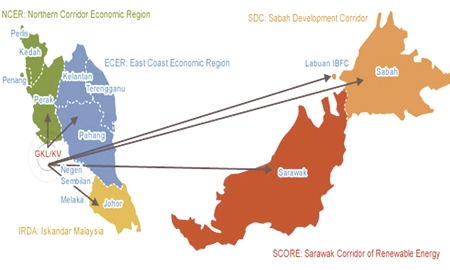Located at the top of the beautiful island of Borneo, Sabah is Malaysia’s easternmost state, and the second largest after its neighbor, Sarawak. A natural paradise, it is probably best known for nature tourism and scuba diving – it boasts some of the world’s top diving sites.
Sabah is rich in natural resources – from its famously diverse flora, fauna and marine life to oil and gas reserves, vast areas of forest timber, oil palm, rubber and cocoa – and it makes a significant contribution to the national economy, contributing the sixth highest amount to Malaysia’s GDP. Yet it is the poorest state in the country. Incomes are low and unemployment high, and its people struggle to make ends meet.
In the not too distant future, however, things could be very different. The Sabah Development Corridor (SDC) was launched in 2008, one of five such economic corridors initiated under the Ninth Malaysia Plan intended to bridge development imbalances in Malaysia and spur economic growth through public-private partnerships.
By 2025, the SDC’s 18-year plan could transform Sabah into a gateway for trade, investment and tourism in the region.
Its success or failure depends on attracting substantial private-sector led investment, and the federal government is contributing billions of dollars to improve the state’s infrastructure and reduce the cost of doing business.
By promoting sectors such as agriculture, tourism and logistics, services, and manufacturing, it is hoped to quadruple Sabah’s GDP to 63 billlion ringgit ($20 billion). Over the three phases of the plan, total investment is forecast to reach 105 billion ringgit, and more than 900,000 new jobs are expected to be created. The plan includes a waterfront city, tourism projects, and a new railway terminal.
“The idea is to tap into the private sector’s capacity, but it has also been recognized that in order to get the private sector to come in, we need to get the infrastructure in place and the investment climate properly developed.” Yaakub Johari, President and CEO of Sedia |
The responsibility for ensuring all this comes about rests with the
Sabah Economic Development and Investment Authority (
SEDIA). Yaakub Johari, SEDIA’s president and chief executive officer, says the SDC will enable Sabah to catch up with the rest of the nation.
“The idea is to tap into the private sector’s capacity, but it has also been recognized that in order to get the private sector to come in, we need to get the infrastructure in place and the investment climate properly developed. This is basically what we were doing during the first phase. The private sector is expected to come in at a later stage to provide sustainability.”
He says the first phase, which ran from 2008 to 2010, attracted investor interest from Brunei, Middle Eastern countries, the United States, the United Kingdom, Australia, China, India, South Korea, and Japan. The SDC managed to secure a record 30.6 billion ringgit in investments, whereby 11.95 billion ringgit was realized, surpassing the target of 11.3 billion ringgit. Implementation of SDC projects generated new business and investment opportunities, and created tens of thousands of jobs – 32,900 in 2008, and 40,000 in 2009.
The ongoing second phase, from 2011-2015, will see accelerated economic growth with greater private investment and development of the state’s human resources.
“During this phase, our main focus will be to attract private investment into SDC,” says Dr. Yaakub. SEDIA will continue to implement outstanding SDC projects and carry out new ones, including entry point projects under the federal government’s Economic Transformation Program.
By the end of phase two, tourism is expected to account for 10% of the state’s GDP and the state should see the emergence of small and medium sized enterprises serving downstream manufacturing companies and agri-businesses producing value-added farming products.
By the completion of the third phase, from 2016 to 2025, it is hoped Sabah will have emerged as one of Malaysia’s leading economic regions, particularly, in resource-based industries. Dr. Yaakub envisions Kota Kinabalu, the state capital, becoming one of the most liveable cities in Asia, a magnet for talent, capital, and companies.
“We have a unique value proposition and we are positioning ourselves as a preferred location for business, culture and nature,” he says. “We are realistic about our potential, so we are working on the areas that we can leverage economically. It is very difficult even for other regions in Malaysia to say that they are like Sabah, and the same goes for our neighboring countries. This is the key element that we like to project.”

0 COMMENTS